Vitamin D and Obesity: A Comparative Analysis of Research Studies
VerifiedAdded on 2020/03/23
|16
|4575
|161
Report
AI Summary
This report provides a comparative analysis of three research studies investigating the relationship between Vitamin D deficiency and obesity. The studies explore the impact of Vitamin D supplementation on weight loss, the prevalence of deficiency in obese children, and the associated health implications. The first study, a randomized controlled trial, examined the effects of Vitamin D supplementation on postmenopausal women undergoing weight loss. The second study focused on Vitamin D deficiency in obese children and its correlation with inflammatory markers and insulin sensitivity. The third study, a cross-sectional analysis, examined the prevalence of Vitamin D deficiency among overweight and obese children. The report compares the methodologies, participant characteristics, and key findings of each study. It highlights the consensus that Vitamin D deficiency is a significant marker for obesity, although not directly linked to weight loss. The report concludes by discussing the implications of these findings for targeted screening and treatment, emphasizing the importance of addressing Vitamin D deficiency in overweight and obese individuals to improve overall health outcomes. It also provides a tabular representation of the comparative study of the articles, and a discussion and analysis section.

Running head: VITAMIN D
Vitamin D Deficiency and Obesity
Name of the Student
Name of the University
Author Note
Vitamin D Deficiency and Obesity
Name of the Student
Name of the University
Author Note
Paraphrase This Document
Need a fresh take? Get an instant paraphrase of this document with our AI Paraphraser
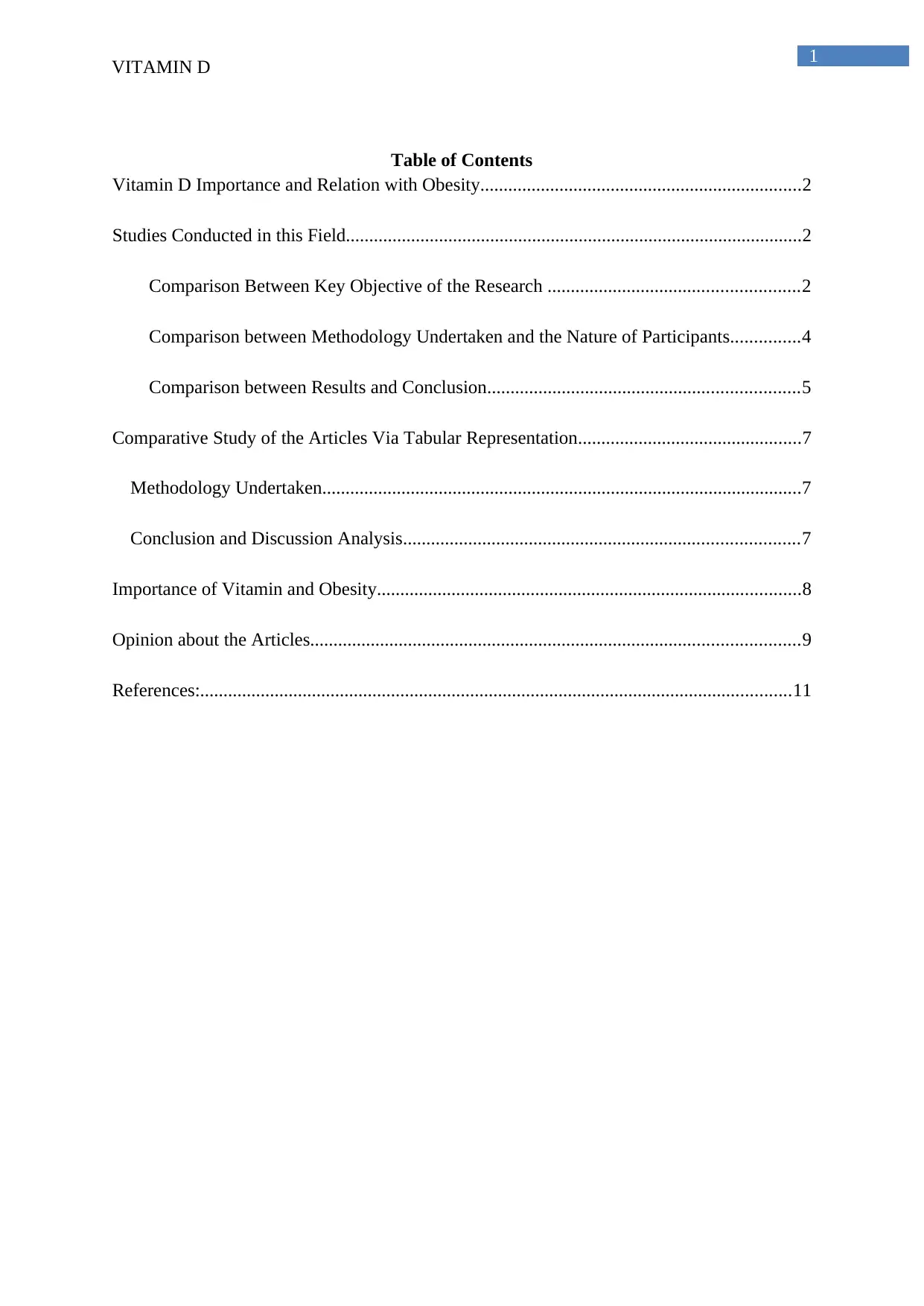
1
VITAMIN D
Table of Contents
Vitamin D Importance and Relation with Obesity.....................................................................2
Studies Conducted in this Field..................................................................................................2
Comparison Between Key Objective of the Research ......................................................2
Comparison between Methodology Undertaken and the Nature of Participants...............4
Comparison between Results and Conclusion...................................................................5
Comparative Study of the Articles Via Tabular Representation................................................7
Methodology Undertaken.......................................................................................................7
Conclusion and Discussion Analysis.....................................................................................7
Importance of Vitamin and Obesity...........................................................................................8
Opinion about the Articles.........................................................................................................9
References:...............................................................................................................................11
VITAMIN D
Table of Contents
Vitamin D Importance and Relation with Obesity.....................................................................2
Studies Conducted in this Field..................................................................................................2
Comparison Between Key Objective of the Research ......................................................2
Comparison between Methodology Undertaken and the Nature of Participants...............4
Comparison between Results and Conclusion...................................................................5
Comparative Study of the Articles Via Tabular Representation................................................7
Methodology Undertaken.......................................................................................................7
Conclusion and Discussion Analysis.....................................................................................7
Importance of Vitamin and Obesity...........................................................................................8
Opinion about the Articles.........................................................................................................9
References:...............................................................................................................................11
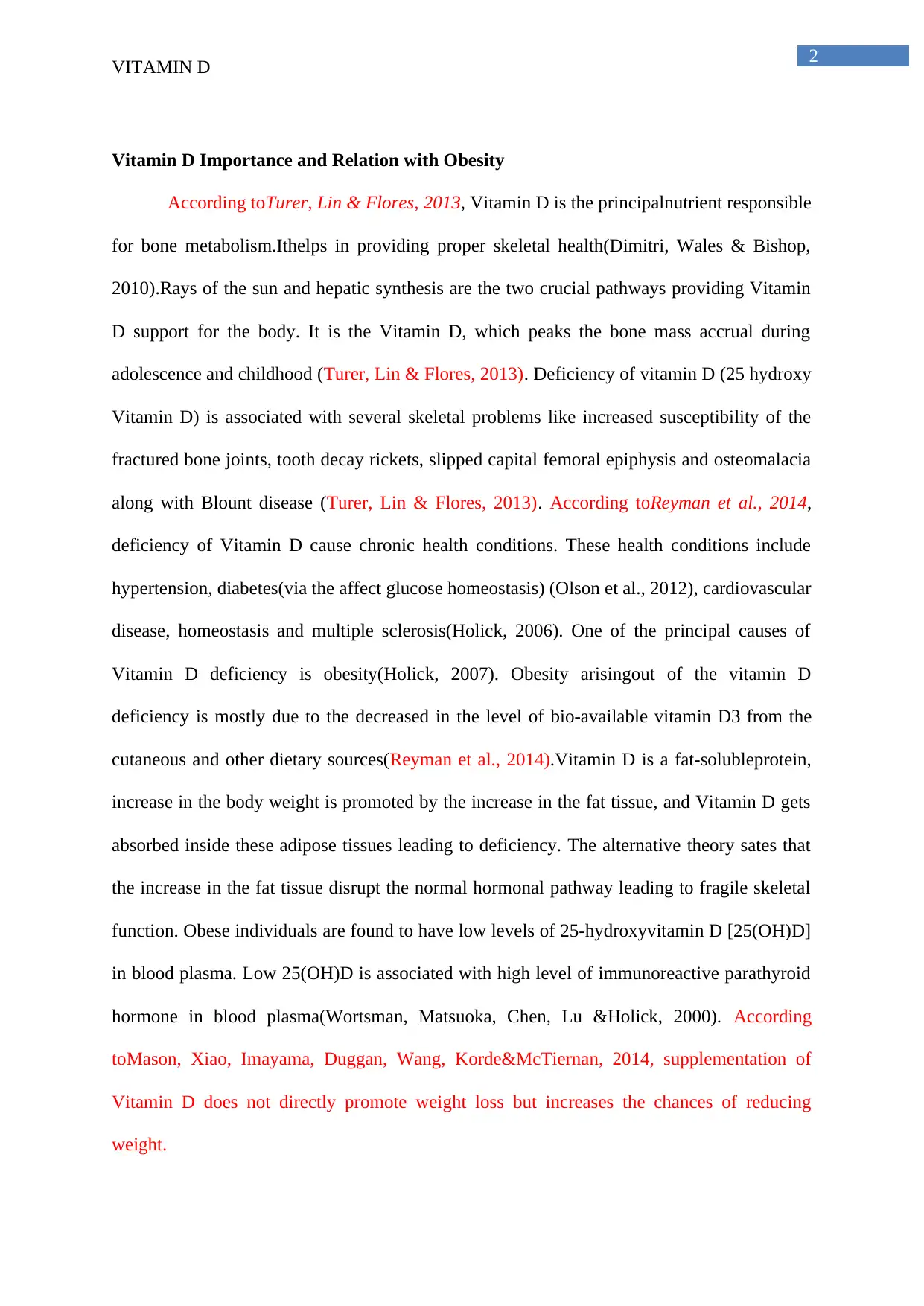
2
VITAMIN D
Vitamin D Importance and Relation with Obesity
According toTurer, Lin & Flores, 2013, Vitamin D is the principalnutrient responsible
for bone metabolism.Ithelps in providing proper skeletal health(Dimitri, Wales & Bishop,
2010).Rays of the sun and hepatic synthesis are the two crucial pathways providing Vitamin
D support for the body. It is the Vitamin D, which peaks the bone mass accrual during
adolescence and childhood (Turer, Lin & Flores, 2013). Deficiency of vitamin D (25 hydroxy
Vitamin D) is associated with several skeletal problems like increased susceptibility of the
fractured bone joints, tooth decay rickets, slipped capital femoral epiphysis and osteomalacia
along with Blount disease (Turer, Lin & Flores, 2013). According toReyman et al., 2014,
deficiency of Vitamin D cause chronic health conditions. These health conditions include
hypertension, diabetes(via the affect glucose homeostasis) (Olson et al., 2012), cardiovascular
disease, homeostasis and multiple sclerosis(Holick, 2006). One of the principal causes of
Vitamin D deficiency is obesity(Holick, 2007). Obesity arisingout of the vitamin D
deficiency is mostly due to the decreased in the level of bio-available vitamin D3 from the
cutaneous and other dietary sources(Reyman et al., 2014).Vitamin D is a fat-solubleprotein,
increase in the body weight is promoted by the increase in the fat tissue, and Vitamin D gets
absorbed inside these adipose tissues leading to deficiency. The alternative theory sates that
the increase in the fat tissue disrupt the normal hormonal pathway leading to fragile skeletal
function. Obese individuals are found to have low levels of 25-hydroxyvitamin D [25(OH)D]
in blood plasma. Low 25(OH)D is associated with high level of immunoreactive parathyroid
hormone in blood plasma(Wortsman, Matsuoka, Chen, Lu &Holick, 2000). According
toMason, Xiao, Imayama, Duggan, Wang, Korde&McTiernan, 2014, supplementation of
Vitamin D does not directly promote weight loss but increases the chances of reducing
weight.
VITAMIN D
Vitamin D Importance and Relation with Obesity
According toTurer, Lin & Flores, 2013, Vitamin D is the principalnutrient responsible
for bone metabolism.Ithelps in providing proper skeletal health(Dimitri, Wales & Bishop,
2010).Rays of the sun and hepatic synthesis are the two crucial pathways providing Vitamin
D support for the body. It is the Vitamin D, which peaks the bone mass accrual during
adolescence and childhood (Turer, Lin & Flores, 2013). Deficiency of vitamin D (25 hydroxy
Vitamin D) is associated with several skeletal problems like increased susceptibility of the
fractured bone joints, tooth decay rickets, slipped capital femoral epiphysis and osteomalacia
along with Blount disease (Turer, Lin & Flores, 2013). According toReyman et al., 2014,
deficiency of Vitamin D cause chronic health conditions. These health conditions include
hypertension, diabetes(via the affect glucose homeostasis) (Olson et al., 2012), cardiovascular
disease, homeostasis and multiple sclerosis(Holick, 2006). One of the principal causes of
Vitamin D deficiency is obesity(Holick, 2007). Obesity arisingout of the vitamin D
deficiency is mostly due to the decreased in the level of bio-available vitamin D3 from the
cutaneous and other dietary sources(Reyman et al., 2014).Vitamin D is a fat-solubleprotein,
increase in the body weight is promoted by the increase in the fat tissue, and Vitamin D gets
absorbed inside these adipose tissues leading to deficiency. The alternative theory sates that
the increase in the fat tissue disrupt the normal hormonal pathway leading to fragile skeletal
function. Obese individuals are found to have low levels of 25-hydroxyvitamin D [25(OH)D]
in blood plasma. Low 25(OH)D is associated with high level of immunoreactive parathyroid
hormone in blood plasma(Wortsman, Matsuoka, Chen, Lu &Holick, 2000). According
toMason, Xiao, Imayama, Duggan, Wang, Korde&McTiernan, 2014, supplementation of
Vitamin D does not directly promote weight loss but increases the chances of reducing
weight.
⊘ This is a preview!⊘
Do you want full access?
Subscribe today to unlock all pages.

Trusted by 1+ million students worldwide
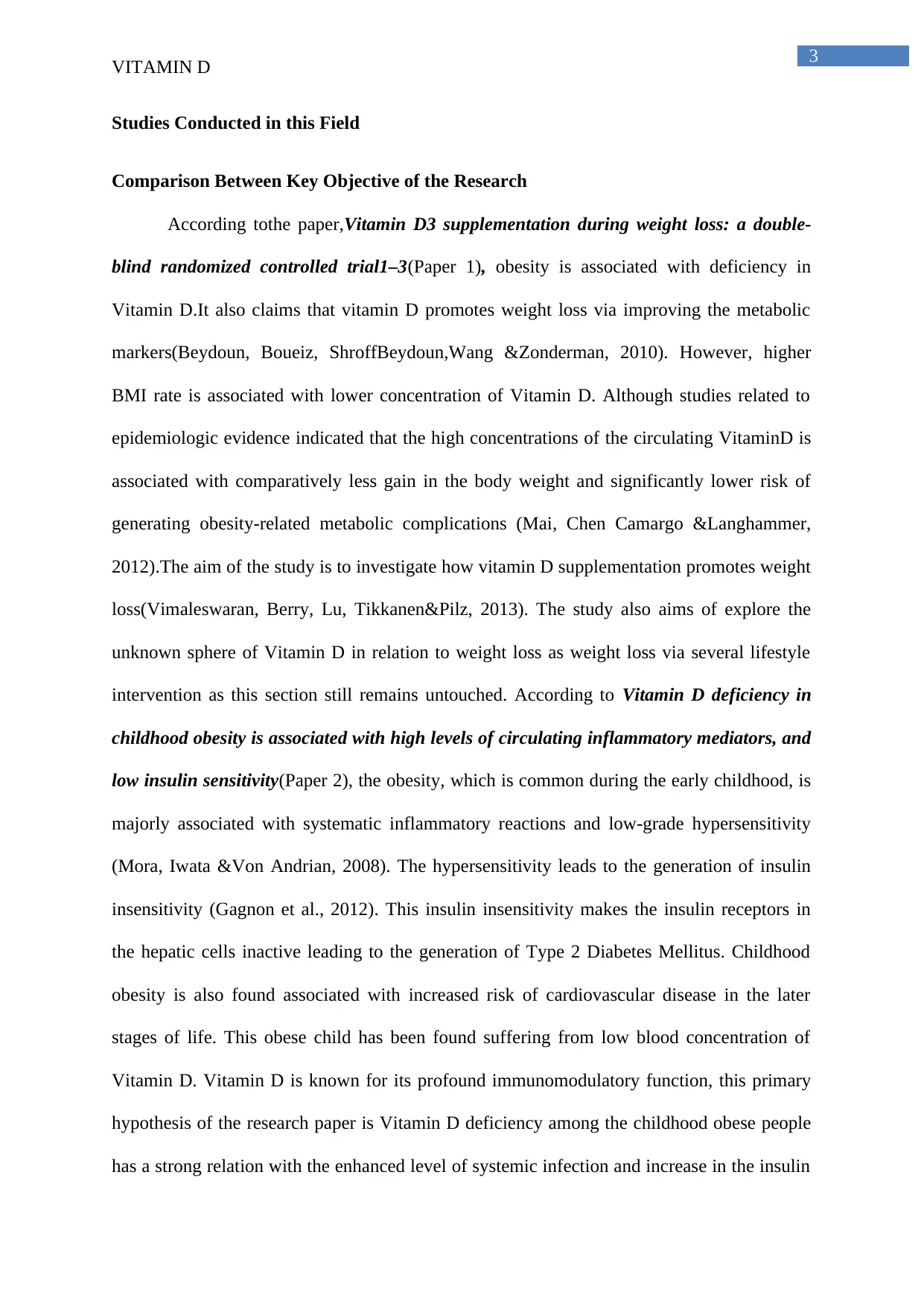
3
VITAMIN D
Studies Conducted in this Field
Comparison Between Key Objective of the Research
According tothe paper,Vitamin D3 supplementation during weight loss: a double-
blind randomized controlled trial1–3(Paper 1), obesity is associated with deficiency in
Vitamin D.It also claims that vitamin D promotes weight loss via improving the metabolic
markers(Beydoun, Boueiz, ShroffBeydoun,Wang &Zonderman, 2010). However, higher
BMI rate is associated with lower concentration of Vitamin D. Although studies related to
epidemiologic evidence indicated that the high concentrations of the circulating VitaminD is
associated with comparatively less gain in the body weight and significantly lower risk of
generating obesity-related metabolic complications (Mai, Chen Camargo &Langhammer,
2012).The aim of the study is to investigate how vitamin D supplementation promotes weight
loss(Vimaleswaran, Berry, Lu, Tikkanen&Pilz, 2013). The study also aims of explore the
unknown sphere of Vitamin D in relation to weight loss as weight loss via several lifestyle
intervention as this section still remains untouched. According to Vitamin D deficiency in
childhood obesity is associated with high levels of circulating inflammatory mediators, and
low insulin sensitivity(Paper 2), the obesity, which is common during the early childhood, is
majorly associated with systematic inflammatory reactions and low-grade hypersensitivity
(Mora, Iwata &Von Andrian, 2008). The hypersensitivity leads to the generation of insulin
insensitivity (Gagnon et al., 2012). This insulin insensitivity makes the insulin receptors in
the hepatic cells inactive leading to the generation of Type 2 Diabetes Mellitus. Childhood
obesity is also found associated with increased risk of cardiovascular disease in the later
stages of life. This obese child has been found suffering from low blood concentration of
Vitamin D. Vitamin D is known for its profound immunomodulatory function, this primary
hypothesis of the research paper is Vitamin D deficiency among the childhood obese people
has a strong relation with the enhanced level of systemic infection and increase in the insulin
VITAMIN D
Studies Conducted in this Field
Comparison Between Key Objective of the Research
According tothe paper,Vitamin D3 supplementation during weight loss: a double-
blind randomized controlled trial1–3(Paper 1), obesity is associated with deficiency in
Vitamin D.It also claims that vitamin D promotes weight loss via improving the metabolic
markers(Beydoun, Boueiz, ShroffBeydoun,Wang &Zonderman, 2010). However, higher
BMI rate is associated with lower concentration of Vitamin D. Although studies related to
epidemiologic evidence indicated that the high concentrations of the circulating VitaminD is
associated with comparatively less gain in the body weight and significantly lower risk of
generating obesity-related metabolic complications (Mai, Chen Camargo &Langhammer,
2012).The aim of the study is to investigate how vitamin D supplementation promotes weight
loss(Vimaleswaran, Berry, Lu, Tikkanen&Pilz, 2013). The study also aims of explore the
unknown sphere of Vitamin D in relation to weight loss as weight loss via several lifestyle
intervention as this section still remains untouched. According to Vitamin D deficiency in
childhood obesity is associated with high levels of circulating inflammatory mediators, and
low insulin sensitivity(Paper 2), the obesity, which is common during the early childhood, is
majorly associated with systematic inflammatory reactions and low-grade hypersensitivity
(Mora, Iwata &Von Andrian, 2008). The hypersensitivity leads to the generation of insulin
insensitivity (Gagnon et al., 2012). This insulin insensitivity makes the insulin receptors in
the hepatic cells inactive leading to the generation of Type 2 Diabetes Mellitus. Childhood
obesity is also found associated with increased risk of cardiovascular disease in the later
stages of life. This obese child has been found suffering from low blood concentration of
Vitamin D. Vitamin D is known for its profound immunomodulatory function, this primary
hypothesis of the research paper is Vitamin D deficiency among the childhood obese people
has a strong relation with the enhanced level of systemic infection and increase in the insulin
Paraphrase This Document
Need a fresh take? Get an instant paraphrase of this document with our AI Paraphraser
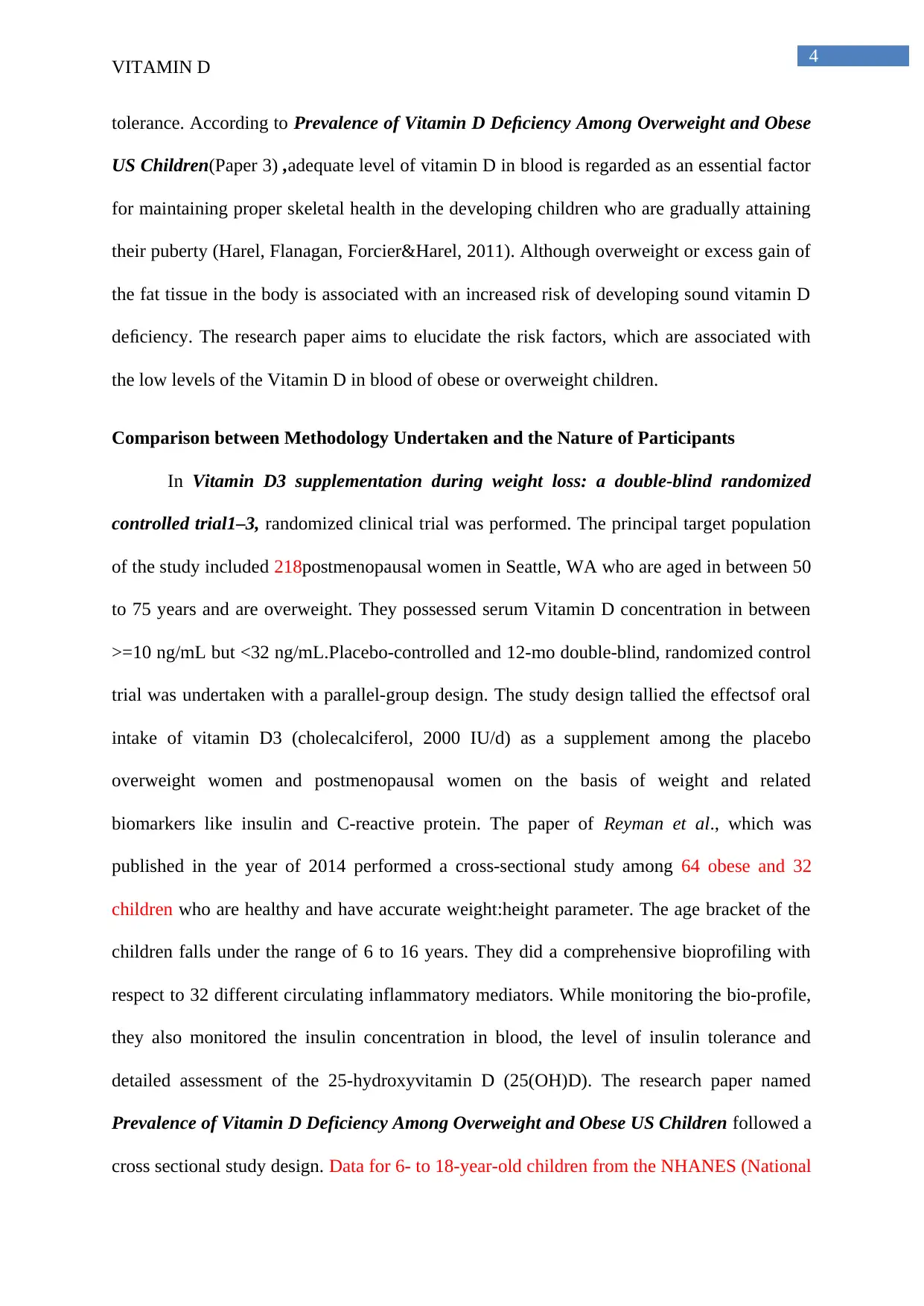
4
VITAMIN D
tolerance. According to Prevalence of Vitamin D Deficiency Among Overweight and Obese
US Children(Paper 3) ,adequate level of vitamin D in blood is regarded as an essential factor
for maintaining proper skeletal health in the developing children who are gradually attaining
their puberty (Harel, Flanagan, Forcier&Harel, 2011). Although overweight or excess gain of
the fat tissue in the body is associated with an increased risk of developing sound vitamin D
deficiency. The research paper aims to elucidate the risk factors, which are associated with
the low levels of the Vitamin D in blood of obese or overweight children.
Comparison between Methodology Undertaken and the Nature of Participants
In Vitamin D3 supplementation during weight loss: a double-blind randomized
controlled trial1–3, randomized clinical trial was performed. The principal target population
of the study included 218postmenopausal women in Seattle, WA who are aged in between 50
to 75 years and are overweight. They possessed serum Vitamin D concentration in between
>=10 ng/mL but <32 ng/mL.Placebo-controlled and 12-mo double-blind, randomized control
trial was undertaken with a parallel-group design. The study design tallied the effectsof oral
intake of vitamin D3 (cholecalciferol, 2000 IU/d) as a supplement among the placebo
overweight women and postmenopausal women on the basis of weight and related
biomarkers like insulin and C-reactive protein. The paper of Reyman et al., which was
published in the year of 2014 performed a cross-sectional study among 64 obese and 32
children who are healthy and have accurate weight:height parameter. The age bracket of the
children falls under the range of 6 to 16 years. They did a comprehensive bioprofiling with
respect to 32 different circulating inflammatory mediators. While monitoring the bio-profile,
they also monitored the insulin concentration in blood, the level of insulin tolerance and
detailed assessment of the 25-hydroxyvitamin D (25(OH)D). The research paper named
Prevalence of Vitamin D Deficiency Among Overweight and Obese US Children followed a
cross sectional study design. Data for 6- to 18-year-old children from the NHANES (National
VITAMIN D
tolerance. According to Prevalence of Vitamin D Deficiency Among Overweight and Obese
US Children(Paper 3) ,adequate level of vitamin D in blood is regarded as an essential factor
for maintaining proper skeletal health in the developing children who are gradually attaining
their puberty (Harel, Flanagan, Forcier&Harel, 2011). Although overweight or excess gain of
the fat tissue in the body is associated with an increased risk of developing sound vitamin D
deficiency. The research paper aims to elucidate the risk factors, which are associated with
the low levels of the Vitamin D in blood of obese or overweight children.
Comparison between Methodology Undertaken and the Nature of Participants
In Vitamin D3 supplementation during weight loss: a double-blind randomized
controlled trial1–3, randomized clinical trial was performed. The principal target population
of the study included 218postmenopausal women in Seattle, WA who are aged in between 50
to 75 years and are overweight. They possessed serum Vitamin D concentration in between
>=10 ng/mL but <32 ng/mL.Placebo-controlled and 12-mo double-blind, randomized control
trial was undertaken with a parallel-group design. The study design tallied the effectsof oral
intake of vitamin D3 (cholecalciferol, 2000 IU/d) as a supplement among the placebo
overweight women and postmenopausal women on the basis of weight and related
biomarkers like insulin and C-reactive protein. The paper of Reyman et al., which was
published in the year of 2014 performed a cross-sectional study among 64 obese and 32
children who are healthy and have accurate weight:height parameter. The age bracket of the
children falls under the range of 6 to 16 years. They did a comprehensive bioprofiling with
respect to 32 different circulating inflammatory mediators. While monitoring the bio-profile,
they also monitored the insulin concentration in blood, the level of insulin tolerance and
detailed assessment of the 25-hydroxyvitamin D (25(OH)D). The research paper named
Prevalence of Vitamin D Deficiency Among Overweight and Obese US Children followed a
cross sectional study design. Data for 6- to 18-year-old children from the NHANES (National
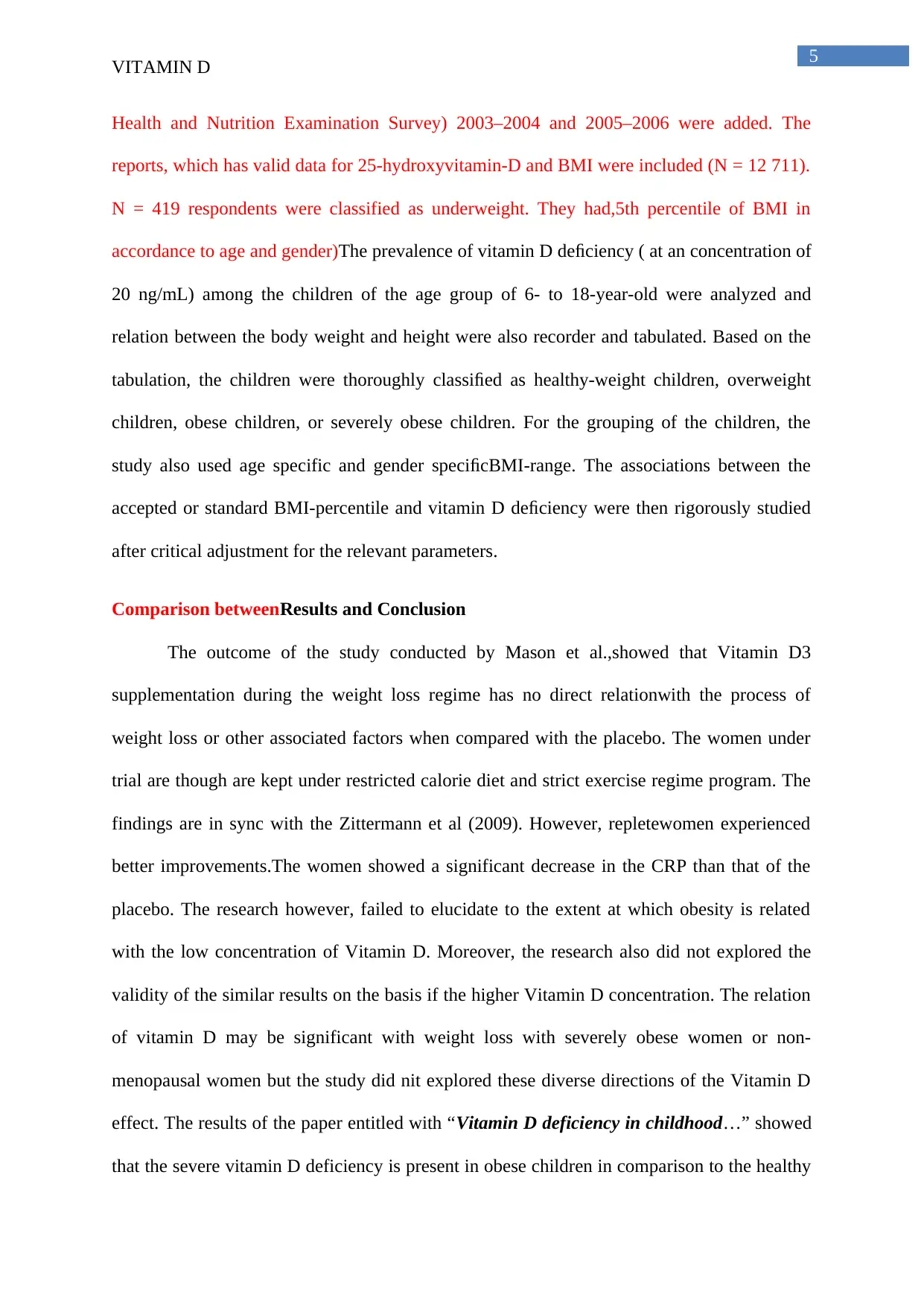
5
VITAMIN D
Health and Nutrition Examination Survey) 2003–2004 and 2005–2006 were added. The
reports, which has valid data for 25-hydroxyvitamin-D and BMI were included (N = 12 711).
N = 419 respondents were classified as underweight. They had,5th percentile of BMI in
accordance to age and gender)The prevalence of vitamin D deficiency ( at an concentration of
20 ng/mL) among the children of the age group of 6- to 18-year-old were analyzed and
relation between the body weight and height were also recorder and tabulated. Based on the
tabulation, the children were thoroughly classified as healthy-weight children, overweight
children, obese children, or severely obese children. For the grouping of the children, the
study also used age specific and gender specificBMI-range. The associations between the
accepted or standard BMI-percentile and vitamin D deficiency were then rigorously studied
after critical adjustment for the relevant parameters.
Comparison betweenResults and Conclusion
The outcome of the study conducted by Mason et al.,showed that Vitamin D3
supplementation during the weight loss regime has no direct relationwith the process of
weight loss or other associated factors when compared with the placebo. The women under
trial are though are kept under restricted calorie diet and strict exercise regime program. The
findings are in sync with the Zittermann et al (2009). However, repletewomen experienced
better improvements.The women showed a significant decrease in the CRP than that of the
placebo. The research however, failed to elucidate to the extent at which obesity is related
with the low concentration of Vitamin D. Moreover, the research also did not explored the
validity of the similar results on the basis if the higher Vitamin D concentration. The relation
of vitamin D may be significant with weight loss with severely obese women or non-
menopausal women but the study did nit explored these diverse directions of the Vitamin D
effect. The results of the paper entitled with “Vitamin D deficiency in childhood…” showed
that the severe vitamin D deficiency is present in obese children in comparison to the healthy
VITAMIN D
Health and Nutrition Examination Survey) 2003–2004 and 2005–2006 were added. The
reports, which has valid data for 25-hydroxyvitamin-D and BMI were included (N = 12 711).
N = 419 respondents were classified as underweight. They had,5th percentile of BMI in
accordance to age and gender)The prevalence of vitamin D deficiency ( at an concentration of
20 ng/mL) among the children of the age group of 6- to 18-year-old were analyzed and
relation between the body weight and height were also recorder and tabulated. Based on the
tabulation, the children were thoroughly classified as healthy-weight children, overweight
children, obese children, or severely obese children. For the grouping of the children, the
study also used age specific and gender specificBMI-range. The associations between the
accepted or standard BMI-percentile and vitamin D deficiency were then rigorously studied
after critical adjustment for the relevant parameters.
Comparison betweenResults and Conclusion
The outcome of the study conducted by Mason et al.,showed that Vitamin D3
supplementation during the weight loss regime has no direct relationwith the process of
weight loss or other associated factors when compared with the placebo. The women under
trial are though are kept under restricted calorie diet and strict exercise regime program. The
findings are in sync with the Zittermann et al (2009). However, repletewomen experienced
better improvements.The women showed a significant decrease in the CRP than that of the
placebo. The research however, failed to elucidate to the extent at which obesity is related
with the low concentration of Vitamin D. Moreover, the research also did not explored the
validity of the similar results on the basis if the higher Vitamin D concentration. The relation
of vitamin D may be significant with weight loss with severely obese women or non-
menopausal women but the study did nit explored these diverse directions of the Vitamin D
effect. The results of the paper entitled with “Vitamin D deficiency in childhood…” showed
that the severe vitamin D deficiency is present in obese children in comparison to the healthy
⊘ This is a preview!⊘
Do you want full access?
Subscribe today to unlock all pages.

Trusted by 1+ million students worldwide
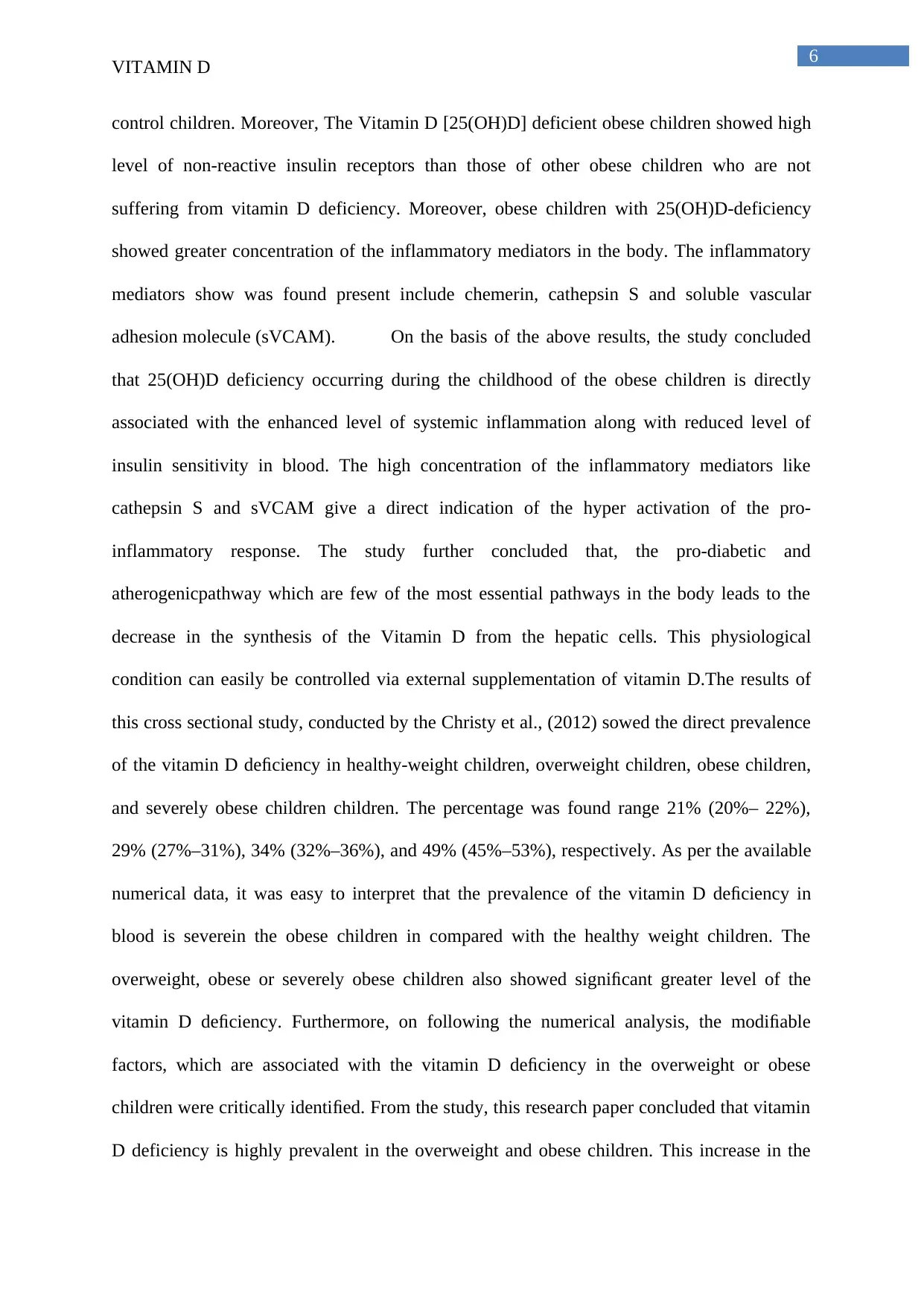
6
VITAMIN D
control children. Moreover, The Vitamin D [25(OH)D] deficient obese children showed high
level of non-reactive insulin receptors than those of other obese children who are not
suffering from vitamin D deficiency. Moreover, obese children with 25(OH)D-deficiency
showed greater concentration of the inflammatory mediators in the body. The inflammatory
mediators show was found present include chemerin, cathepsin S and soluble vascular
adhesion molecule (sVCAM). On the basis of the above results, the study concluded
that 25(OH)D deficiency occurring during the childhood of the obese children is directly
associated with the enhanced level of systemic inflammation along with reduced level of
insulin sensitivity in blood. The high concentration of the inflammatory mediators like
cathepsin S and sVCAM give a direct indication of the hyper activation of the pro-
inflammatory response. The study further concluded that, the pro-diabetic and
atherogenicpathway which are few of the most essential pathways in the body leads to the
decrease in the synthesis of the Vitamin D from the hepatic cells. This physiological
condition can easily be controlled via external supplementation of vitamin D.The results of
this cross sectional study, conducted by the Christy et al., (2012) sowed the direct prevalence
of the vitamin D deficiency in healthy-weight children, overweight children, obese children,
and severely obese children children. The percentage was found range 21% (20%– 22%),
29% (27%–31%), 34% (32%–36%), and 49% (45%–53%), respectively. As per the available
numerical data, it was easy to interpret that the prevalence of the vitamin D deficiency in
blood is severein the obese children in compared with the healthy weight children. The
overweight, obese or severely obese children also showed significant greater level of the
vitamin D deficiency. Furthermore, on following the numerical analysis, the modifiable
factors, which are associated with the vitamin D deficiency in the overweight or obese
children were critically identified. From the study, this research paper concluded that vitamin
D deficiency is highly prevalent in the overweight and obese children. This increase in the
VITAMIN D
control children. Moreover, The Vitamin D [25(OH)D] deficient obese children showed high
level of non-reactive insulin receptors than those of other obese children who are not
suffering from vitamin D deficiency. Moreover, obese children with 25(OH)D-deficiency
showed greater concentration of the inflammatory mediators in the body. The inflammatory
mediators show was found present include chemerin, cathepsin S and soluble vascular
adhesion molecule (sVCAM). On the basis of the above results, the study concluded
that 25(OH)D deficiency occurring during the childhood of the obese children is directly
associated with the enhanced level of systemic inflammation along with reduced level of
insulin sensitivity in blood. The high concentration of the inflammatory mediators like
cathepsin S and sVCAM give a direct indication of the hyper activation of the pro-
inflammatory response. The study further concluded that, the pro-diabetic and
atherogenicpathway which are few of the most essential pathways in the body leads to the
decrease in the synthesis of the Vitamin D from the hepatic cells. This physiological
condition can easily be controlled via external supplementation of vitamin D.The results of
this cross sectional study, conducted by the Christy et al., (2012) sowed the direct prevalence
of the vitamin D deficiency in healthy-weight children, overweight children, obese children,
and severely obese children children. The percentage was found range 21% (20%– 22%),
29% (27%–31%), 34% (32%–36%), and 49% (45%–53%), respectively. As per the available
numerical data, it was easy to interpret that the prevalence of the vitamin D deficiency in
blood is severein the obese children in compared with the healthy weight children. The
overweight, obese or severely obese children also showed significant greater level of the
vitamin D deficiency. Furthermore, on following the numerical analysis, the modifiable
factors, which are associated with the vitamin D deficiency in the overweight or obese
children were critically identified. From the study, this research paper concluded that vitamin
D deficiency is highly prevalent in the overweight and obese children. This increase in the
Paraphrase This Document
Need a fresh take? Get an instant paraphrase of this document with our AI Paraphraser
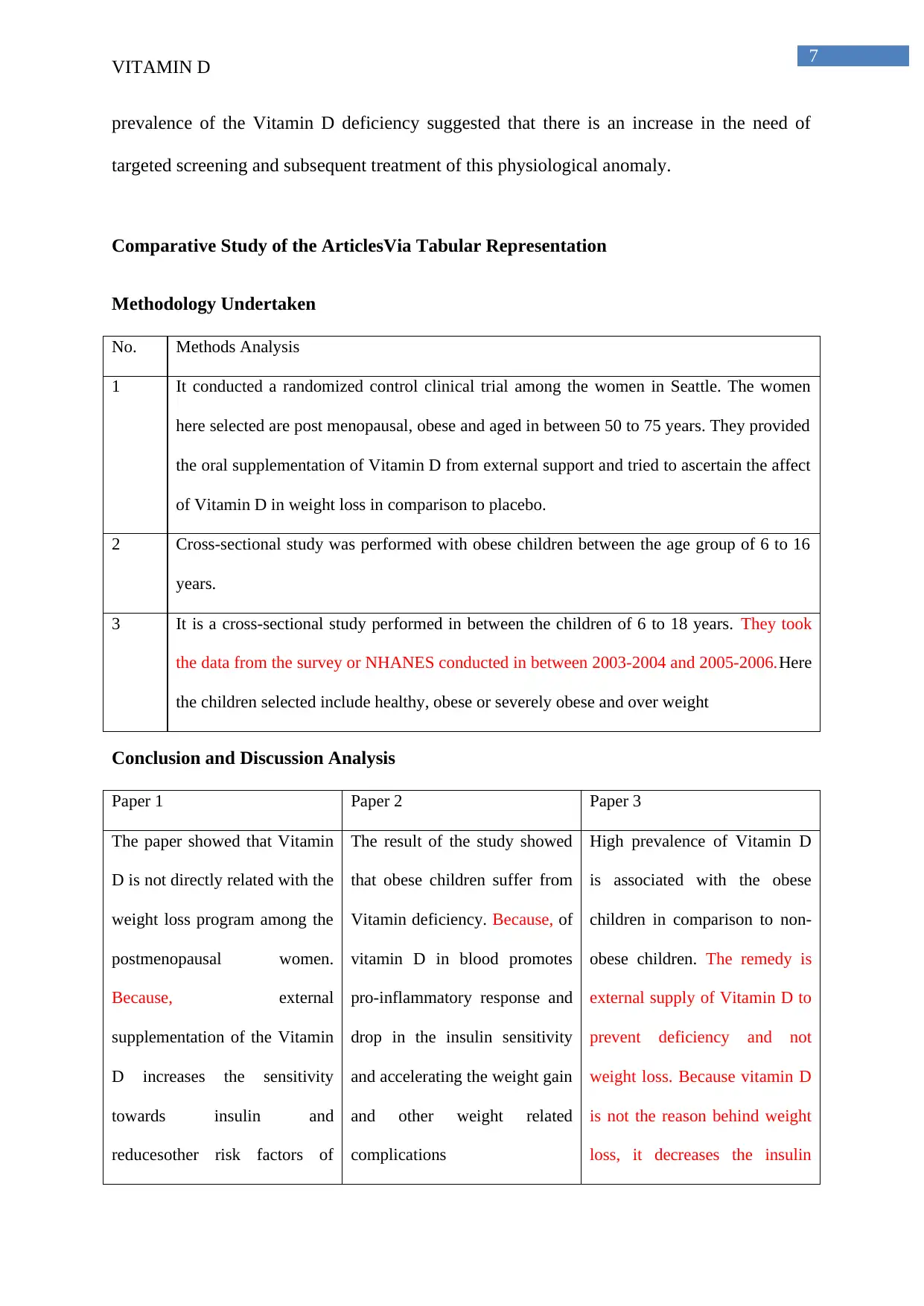
7
VITAMIN D
prevalence of the Vitamin D deficiency suggested that there is an increase in the need of
targeted screening and subsequent treatment of this physiological anomaly.
Comparative Study of the ArticlesVia Tabular Representation
Methodology Undertaken
No. Methods Analysis
1 It conducted a randomized control clinical trial among the women in Seattle. The women
here selected are post menopausal, obese and aged in between 50 to 75 years. They provided
the oral supplementation of Vitamin D from external support and tried to ascertain the affect
of Vitamin D in weight loss in comparison to placebo.
2 Cross-sectional study was performed with obese children between the age group of 6 to 16
years.
3 It is a cross-sectional study performed in between the children of 6 to 18 years. They took
the data from the survey or NHANES conducted in between 2003-2004 and 2005-2006.Here
the children selected include healthy, obese or severely obese and over weight
Conclusion and Discussion Analysis
Paper 1 Paper 2 Paper 3
The paper showed that Vitamin
D is not directly related with the
weight loss program among the
postmenopausal women.
Because, external
supplementation of the Vitamin
D increases the sensitivity
towards insulin and
reducesother risk factors of
The result of the study showed
that obese children suffer from
Vitamin deficiency. Because, of
vitamin D in blood promotes
pro-inflammatory response and
drop in the insulin sensitivity
and accelerating the weight gain
and other weight related
complications
High prevalence of Vitamin D
is associated with the obese
children in comparison to non-
obese children. The remedy is
external supply of Vitamin D to
prevent deficiency and not
weight loss. Because vitamin D
is not the reason behind weight
loss, it decreases the insulin
VITAMIN D
prevalence of the Vitamin D deficiency suggested that there is an increase in the need of
targeted screening and subsequent treatment of this physiological anomaly.
Comparative Study of the ArticlesVia Tabular Representation
Methodology Undertaken
No. Methods Analysis
1 It conducted a randomized control clinical trial among the women in Seattle. The women
here selected are post menopausal, obese and aged in between 50 to 75 years. They provided
the oral supplementation of Vitamin D from external support and tried to ascertain the affect
of Vitamin D in weight loss in comparison to placebo.
2 Cross-sectional study was performed with obese children between the age group of 6 to 16
years.
3 It is a cross-sectional study performed in between the children of 6 to 18 years. They took
the data from the survey or NHANES conducted in between 2003-2004 and 2005-2006.Here
the children selected include healthy, obese or severely obese and over weight
Conclusion and Discussion Analysis
Paper 1 Paper 2 Paper 3
The paper showed that Vitamin
D is not directly related with the
weight loss program among the
postmenopausal women.
Because, external
supplementation of the Vitamin
D increases the sensitivity
towards insulin and
reducesother risk factors of
The result of the study showed
that obese children suffer from
Vitamin deficiency. Because, of
vitamin D in blood promotes
pro-inflammatory response and
drop in the insulin sensitivity
and accelerating the weight gain
and other weight related
complications
High prevalence of Vitamin D
is associated with the obese
children in comparison to non-
obese children. The remedy is
external supply of Vitamin D to
prevent deficiency and not
weight loss. Because vitamin D
is not the reason behind weight
loss, it decreases the insulin
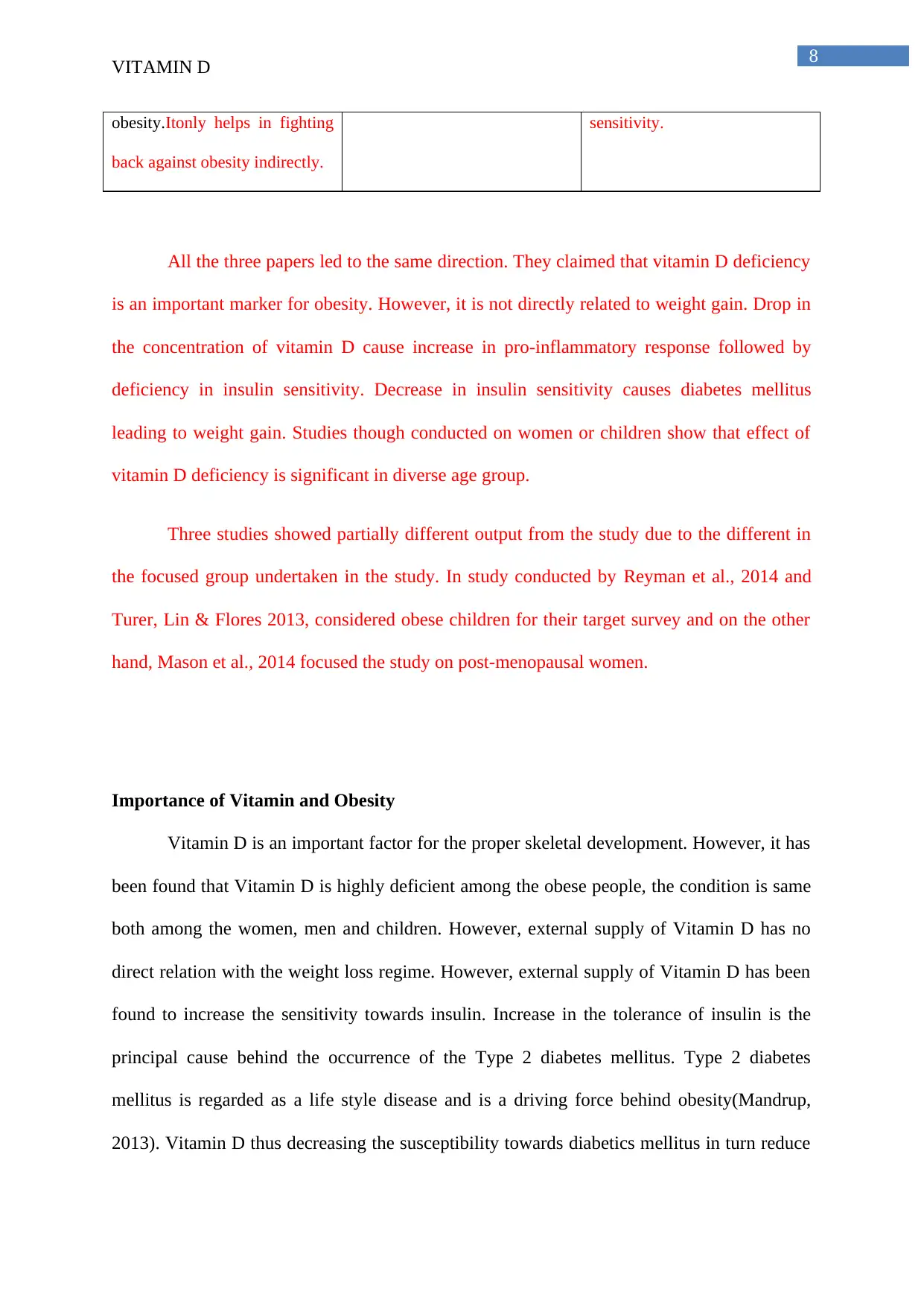
8
VITAMIN D
obesity.Itonly helps in fighting
back against obesity indirectly.
sensitivity.
All the three papers led to the same direction. They claimed that vitamin D deficiency
is an important marker for obesity. However, it is not directly related to weight gain. Drop in
the concentration of vitamin D cause increase in pro-inflammatory response followed by
deficiency in insulin sensitivity. Decrease in insulin sensitivity causes diabetes mellitus
leading to weight gain. Studies though conducted on women or children show that effect of
vitamin D deficiency is significant in diverse age group.
Three studies showed partially different output from the study due to the different in
the focused group undertaken in the study. In study conducted by Reyman et al., 2014 and
Turer, Lin & Flores 2013, considered obese children for their target survey and on the other
hand, Mason et al., 2014 focused the study on post-menopausal women.
Importance of Vitamin and Obesity
Vitamin D is an important factor for the proper skeletal development. However, it has
been found that Vitamin D is highly deficient among the obese people, the condition is same
both among the women, men and children. However, external supply of Vitamin D has no
direct relation with the weight loss regime. However, external supply of Vitamin D has been
found to increase the sensitivity towards insulin. Increase in the tolerance of insulin is the
principal cause behind the occurrence of the Type 2 diabetes mellitus. Type 2 diabetes
mellitus is regarded as a life style disease and is a driving force behind obesity(Mandrup,
2013). Vitamin D thus decreasing the susceptibility towards diabetics mellitus in turn reduce
VITAMIN D
obesity.Itonly helps in fighting
back against obesity indirectly.
sensitivity.
All the three papers led to the same direction. They claimed that vitamin D deficiency
is an important marker for obesity. However, it is not directly related to weight gain. Drop in
the concentration of vitamin D cause increase in pro-inflammatory response followed by
deficiency in insulin sensitivity. Decrease in insulin sensitivity causes diabetes mellitus
leading to weight gain. Studies though conducted on women or children show that effect of
vitamin D deficiency is significant in diverse age group.
Three studies showed partially different output from the study due to the different in
the focused group undertaken in the study. In study conducted by Reyman et al., 2014 and
Turer, Lin & Flores 2013, considered obese children for their target survey and on the other
hand, Mason et al., 2014 focused the study on post-menopausal women.
Importance of Vitamin and Obesity
Vitamin D is an important factor for the proper skeletal development. However, it has
been found that Vitamin D is highly deficient among the obese people, the condition is same
both among the women, men and children. However, external supply of Vitamin D has no
direct relation with the weight loss regime. However, external supply of Vitamin D has been
found to increase the sensitivity towards insulin. Increase in the tolerance of insulin is the
principal cause behind the occurrence of the Type 2 diabetes mellitus. Type 2 diabetes
mellitus is regarded as a life style disease and is a driving force behind obesity(Mandrup,
2013). Vitamin D thus decreasing the susceptibility towards diabetics mellitus in turn reduce
⊘ This is a preview!⊘
Do you want full access?
Subscribe today to unlock all pages.

Trusted by 1+ million students worldwide
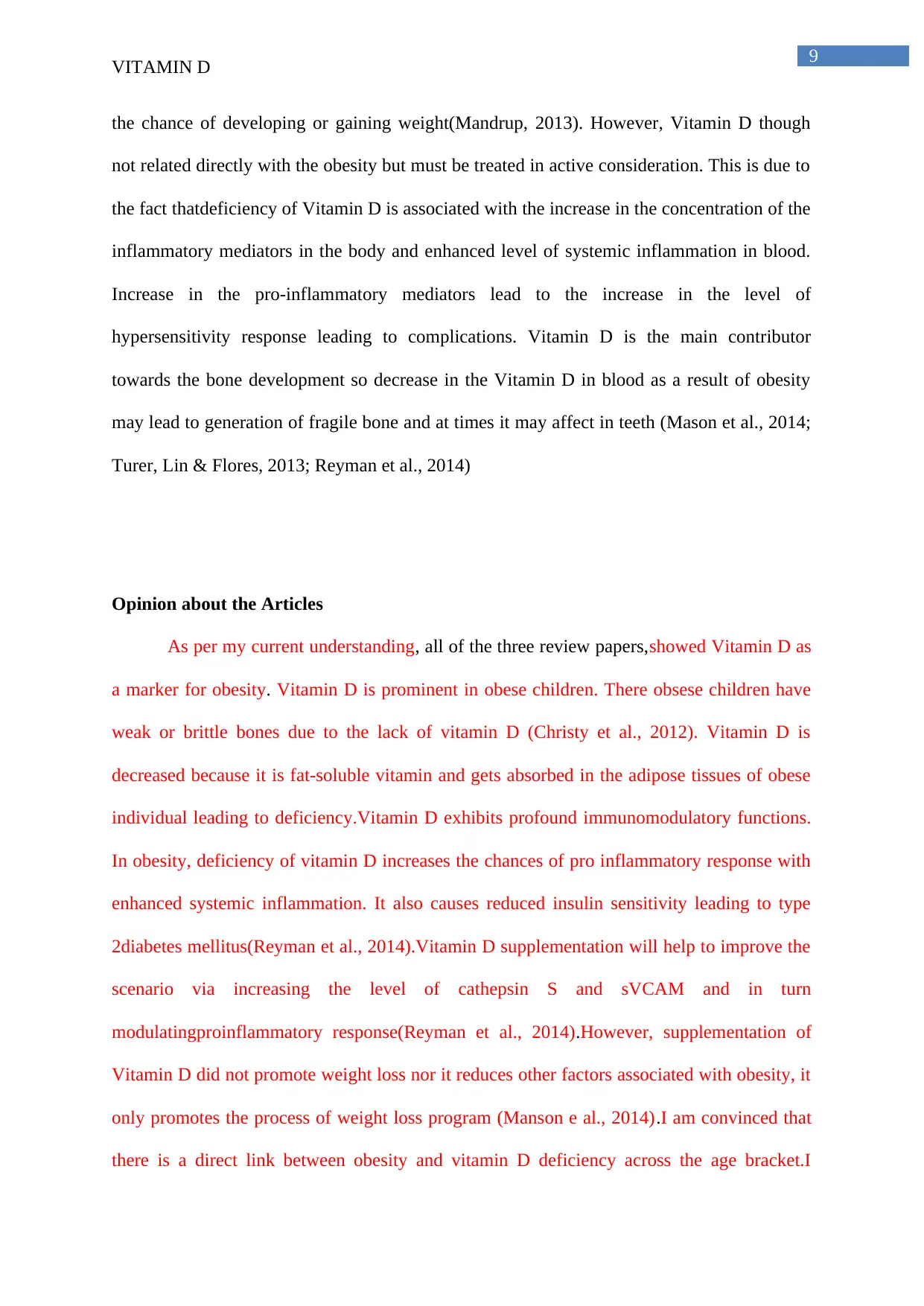
9
VITAMIN D
the chance of developing or gaining weight(Mandrup, 2013). However, Vitamin D though
not related directly with the obesity but must be treated in active consideration. This is due to
the fact thatdeficiency of Vitamin D is associated with the increase in the concentration of the
inflammatory mediators in the body and enhanced level of systemic inflammation in blood.
Increase in the pro-inflammatory mediators lead to the increase in the level of
hypersensitivity response leading to complications. Vitamin D is the main contributor
towards the bone development so decrease in the Vitamin D in blood as a result of obesity
may lead to generation of fragile bone and at times it may affect in teeth (Mason et al., 2014;
Turer, Lin & Flores, 2013; Reyman et al., 2014)
Opinion about the Articles
As per my current understanding, all of the three review papers,showed Vitamin D as
a marker for obesity. Vitamin D is prominent in obese children. There obsese children have
weak or brittle bones due to the lack of vitamin D (Christy et al., 2012). Vitamin D is
decreased because it is fat-soluble vitamin and gets absorbed in the adipose tissues of obese
individual leading to deficiency.Vitamin D exhibits profound immunomodulatory functions.
In obesity, deficiency of vitamin D increases the chances of pro inflammatory response with
enhanced systemic inflammation. It also causes reduced insulin sensitivity leading to type
2diabetes mellitus(Reyman et al., 2014).Vitamin D supplementation will help to improve the
scenario via increasing the level of cathepsin S and sVCAM and in turn
modulatingproinflammatory response(Reyman et al., 2014).However, supplementation of
Vitamin D did not promote weight loss nor it reduces other factors associated with obesity, it
only promotes the process of weight loss program (Manson e al., 2014).I am convinced that
there is a direct link between obesity and vitamin D deficiency across the age bracket.I
VITAMIN D
the chance of developing or gaining weight(Mandrup, 2013). However, Vitamin D though
not related directly with the obesity but must be treated in active consideration. This is due to
the fact thatdeficiency of Vitamin D is associated with the increase in the concentration of the
inflammatory mediators in the body and enhanced level of systemic inflammation in blood.
Increase in the pro-inflammatory mediators lead to the increase in the level of
hypersensitivity response leading to complications. Vitamin D is the main contributor
towards the bone development so decrease in the Vitamin D in blood as a result of obesity
may lead to generation of fragile bone and at times it may affect in teeth (Mason et al., 2014;
Turer, Lin & Flores, 2013; Reyman et al., 2014)
Opinion about the Articles
As per my current understanding, all of the three review papers,showed Vitamin D as
a marker for obesity. Vitamin D is prominent in obese children. There obsese children have
weak or brittle bones due to the lack of vitamin D (Christy et al., 2012). Vitamin D is
decreased because it is fat-soluble vitamin and gets absorbed in the adipose tissues of obese
individual leading to deficiency.Vitamin D exhibits profound immunomodulatory functions.
In obesity, deficiency of vitamin D increases the chances of pro inflammatory response with
enhanced systemic inflammation. It also causes reduced insulin sensitivity leading to type
2diabetes mellitus(Reyman et al., 2014).Vitamin D supplementation will help to improve the
scenario via increasing the level of cathepsin S and sVCAM and in turn
modulatingproinflammatory response(Reyman et al., 2014).However, supplementation of
Vitamin D did not promote weight loss nor it reduces other factors associated with obesity, it
only promotes the process of weight loss program (Manson e al., 2014).I am convinced that
there is a direct link between obesity and vitamin D deficiency across the age bracket.I
Paraphrase This Document
Need a fresh take? Get an instant paraphrase of this document with our AI Paraphraser
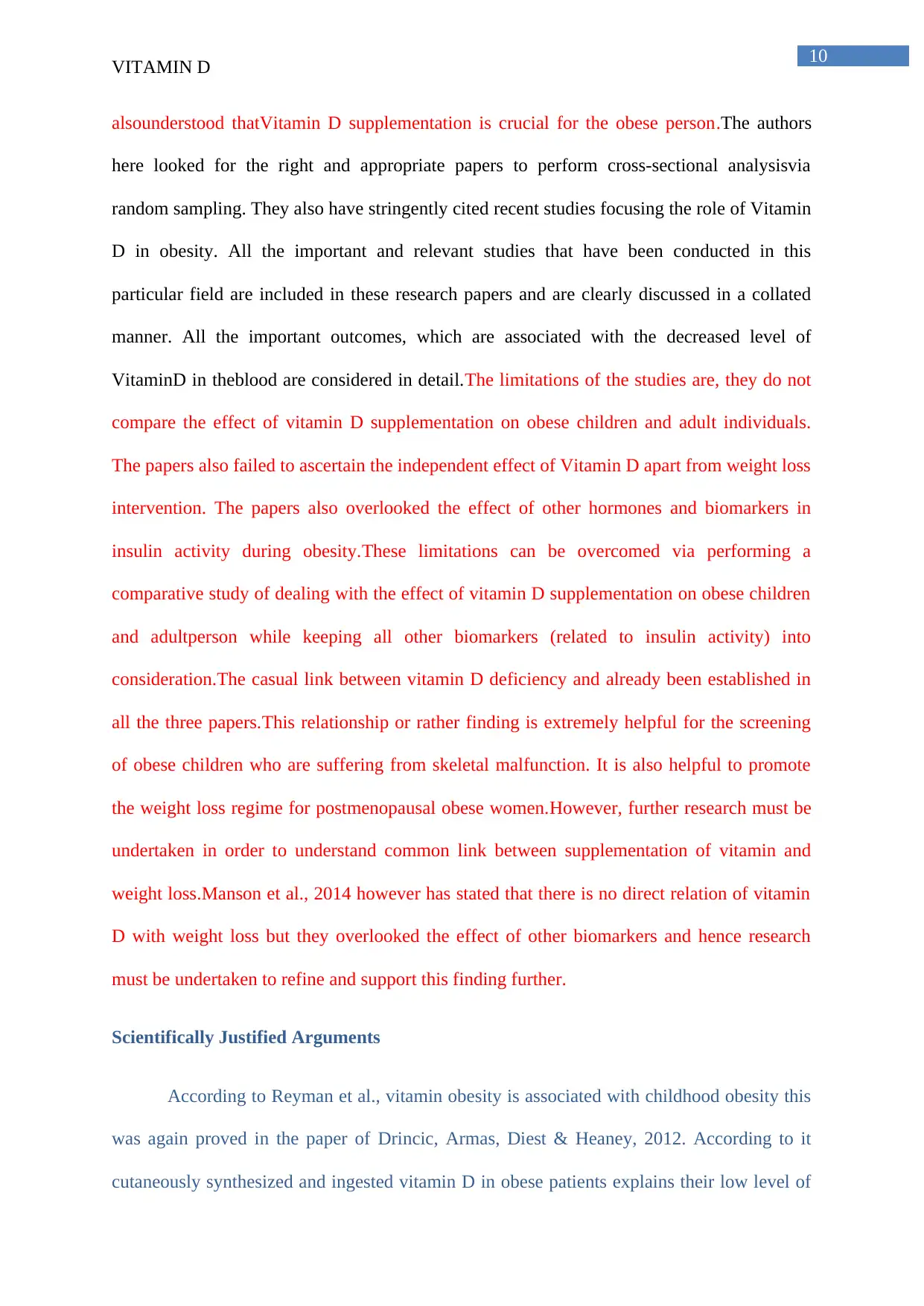
10
VITAMIN D
alsounderstood thatVitamin D supplementation is crucial for the obese person.The authors
here looked for the right and appropriate papers to perform cross-sectional analysisvia
random sampling. They also have stringently cited recent studies focusing the role of Vitamin
D in obesity. All the important and relevant studies that have been conducted in this
particular field are included in these research papers and are clearly discussed in a collated
manner. All the important outcomes, which are associated with the decreased level of
VitaminD in theblood are considered in detail.The limitations of the studies are, they do not
compare the effect of vitamin D supplementation on obese children and adult individuals.
The papers also failed to ascertain the independent effect of Vitamin D apart from weight loss
intervention. The papers also overlooked the effect of other hormones and biomarkers in
insulin activity during obesity.These limitations can be overcomed via performing a
comparative study of dealing with the effect of vitamin D supplementation on obese children
and adultperson while keeping all other biomarkers (related to insulin activity) into
consideration.The casual link between vitamin D deficiency and already been established in
all the three papers.This relationship or rather finding is extremely helpful for the screening
of obese children who are suffering from skeletal malfunction. It is also helpful to promote
the weight loss regime for postmenopausal obese women.However, further research must be
undertaken in order to understand common link between supplementation of vitamin and
weight loss.Manson et al., 2014 however has stated that there is no direct relation of vitamin
D with weight loss but they overlooked the effect of other biomarkers and hence research
must be undertaken to refine and support this finding further.
Scientifically Justified Arguments
According to Reyman et al., vitamin obesity is associated with childhood obesity this
was again proved in the paper of Drincic, Armas, Diest & Heaney, 2012. According to it
cutaneously synthesized and ingested vitamin D in obese patients explains their low level of
VITAMIN D
alsounderstood thatVitamin D supplementation is crucial for the obese person.The authors
here looked for the right and appropriate papers to perform cross-sectional analysisvia
random sampling. They also have stringently cited recent studies focusing the role of Vitamin
D in obesity. All the important and relevant studies that have been conducted in this
particular field are included in these research papers and are clearly discussed in a collated
manner. All the important outcomes, which are associated with the decreased level of
VitaminD in theblood are considered in detail.The limitations of the studies are, they do not
compare the effect of vitamin D supplementation on obese children and adult individuals.
The papers also failed to ascertain the independent effect of Vitamin D apart from weight loss
intervention. The papers also overlooked the effect of other hormones and biomarkers in
insulin activity during obesity.These limitations can be overcomed via performing a
comparative study of dealing with the effect of vitamin D supplementation on obese children
and adultperson while keeping all other biomarkers (related to insulin activity) into
consideration.The casual link between vitamin D deficiency and already been established in
all the three papers.This relationship or rather finding is extremely helpful for the screening
of obese children who are suffering from skeletal malfunction. It is also helpful to promote
the weight loss regime for postmenopausal obese women.However, further research must be
undertaken in order to understand common link between supplementation of vitamin and
weight loss.Manson et al., 2014 however has stated that there is no direct relation of vitamin
D with weight loss but they overlooked the effect of other biomarkers and hence research
must be undertaken to refine and support this finding further.
Scientifically Justified Arguments
According to Reyman et al., vitamin obesity is associated with childhood obesity this
was again proved in the paper of Drincic, Armas, Diest & Heaney, 2012. According to it
cutaneously synthesized and ingested vitamin D in obese patients explains their low level of
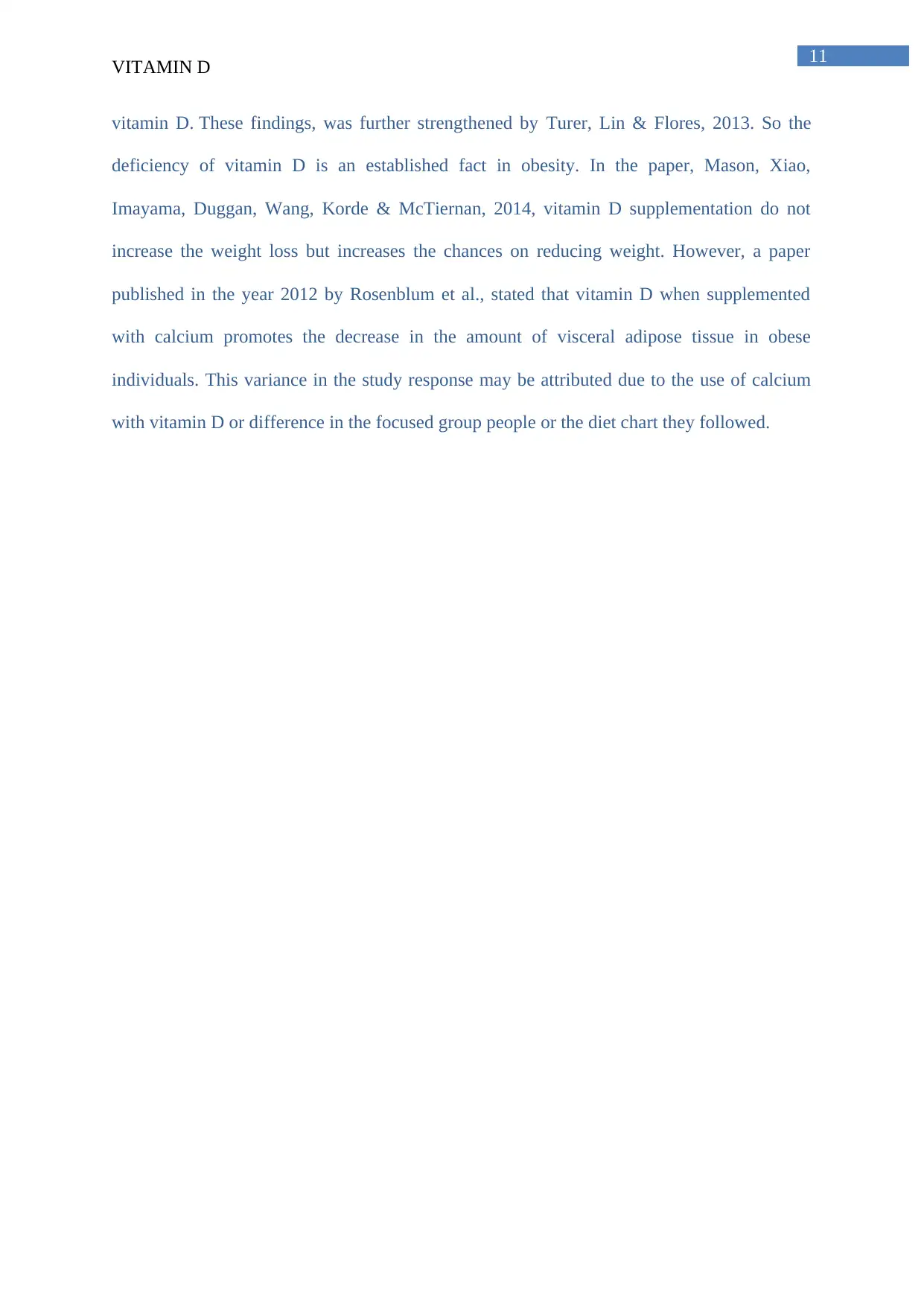
11
VITAMIN D
vitamin D. These findings, was further strengthened by Turer, Lin & Flores, 2013. So the
deficiency of vitamin D is an established fact in obesity. In the paper, Mason, Xiao,
Imayama, Duggan, Wang, Korde & McTiernan, 2014, vitamin D supplementation do not
increase the weight loss but increases the chances on reducing weight. However, a paper
published in the year 2012 by Rosenblum et al., stated that vitamin D when supplemented
with calcium promotes the decrease in the amount of visceral adipose tissue in obese
individuals. This variance in the study response may be attributed due to the use of calcium
with vitamin D or difference in the focused group people or the diet chart they followed.
VITAMIN D
vitamin D. These findings, was further strengthened by Turer, Lin & Flores, 2013. So the
deficiency of vitamin D is an established fact in obesity. In the paper, Mason, Xiao,
Imayama, Duggan, Wang, Korde & McTiernan, 2014, vitamin D supplementation do not
increase the weight loss but increases the chances on reducing weight. However, a paper
published in the year 2012 by Rosenblum et al., stated that vitamin D when supplemented
with calcium promotes the decrease in the amount of visceral adipose tissue in obese
individuals. This variance in the study response may be attributed due to the use of calcium
with vitamin D or difference in the focused group people or the diet chart they followed.
⊘ This is a preview!⊘
Do you want full access?
Subscribe today to unlock all pages.

Trusted by 1+ million students worldwide
1 out of 16
Your All-in-One AI-Powered Toolkit for Academic Success.
+13062052269
info@desklib.com
Available 24*7 on WhatsApp / Email
![[object Object]](/_next/static/media/star-bottom.7253800d.svg)
Unlock your academic potential
Copyright © 2020–2025 A2Z Services. All Rights Reserved. Developed and managed by ZUCOL.


